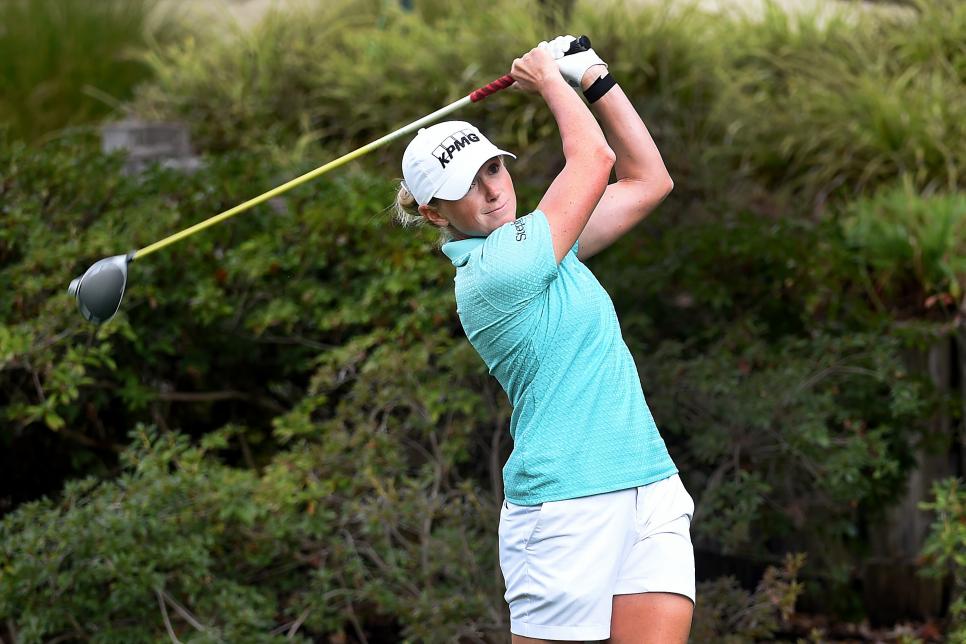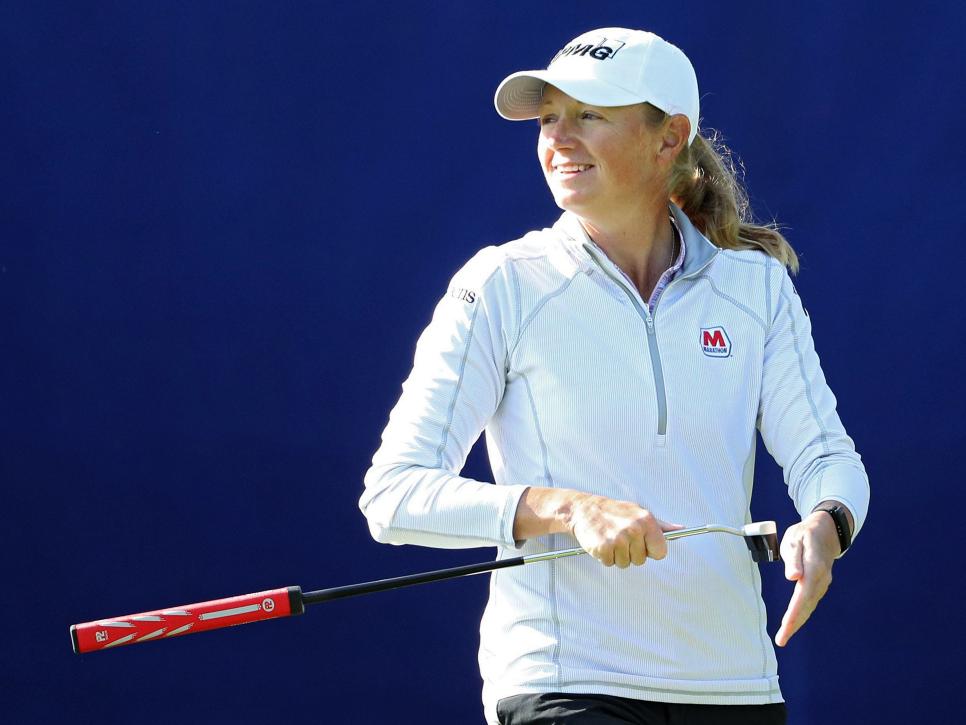Patrick Smith
Stacy Lewis had to make a late run up the money list on the LPGA to qualify for the U.S. Open.
By Keely Levins
Stacy Lewis wanted to get into this year’s U.S. Women’s Open field badly. Sure, any player would want to compete in a major championship, but this one, at Champions Golf Club in Houston, is personal for Lewis. She grew up 45 minutes away, and she and her husband are members at the club.
First, though, she had to get into the field. Originally, her plan was to try to get in via local qualifying. (She was just inside the top 100 of the Rolex Rankings at the beginning of the season, and, as such, not exempt into the Open field.) But then the USGA cancelled all local qualifying due to the spread of COVID-19.
When the exempt categories for the 2020 U.S. Women’s Open field were announced, there was a way Lewis could get in: If she earned enough money by the early November deadline to be among the top 10 LPGA players not already exempt. With three top 10s, including a win in August’s Ladies Scottish Open, she did it.
“I was just glad that when the USGA announced qualifications, there was a way to play in. I was just glad that opportunity was still there,” Lewis said. “I was surprised after I won that I didn’t get in. They called me and told me I was in next year’s U.S. Open. But they said I’d be fine [for this year], just ride it out. It was a relief more than anything that I do get to play at home. It would’ve been pretty frustrating to not be playing there.”
This is Lewis’ 14th U.S. Women’s Open, but the last two have given her a different perspective on the championship. In 2019, she appealed to the USGA to get into the field with a maternity exemption, as her ranking had fallen outside the top 50 when she returned from maternity leave after giving birth to her daughter, Chesnee. She was No. 33 when she left for maternity. Lewis won the appeal and got into the field.
That led to Lewis consulting with the USGA on their maternity-leave policy, which now includes a rule that when you go on maternity leave your ranking is frozen as it relates to qualifying for USGA championships. So, when you return, if you would’ve been eligible before you began maternity leave, you’re still eligible.
“I’ve always been on the forefront of fighting for bigger purses, better tournaments, that kind of stuff,” Lewis said of working with the USGA on its policy. “I think the maternity just kind of goes with it: giving women better opportunities, allowing us to have families and still do our jobs. That’s really what it is. I was really glad they were willing to listen. They called me and asked me, ‘What would you like to see? How can we make this better?’ They thought about it. They really worked on it before they came out with it.”
After what she went through in 2019, then gutting it out to qualify via the money list in 2020, Lewis has a new perspective on what it means to play in the U.S. Women’s Open.
“When you’re No. 1 in the world, and you’re winning, you never even think about qualifying for a U.S. Open,” Lewis said. “I hadn’t thought about qualifying for a U.S. Open for 10 years, I just assumed I’d be there.”
Now that she has had to think about, she comes into Houston reinvigorated.

Steve Dykes
Stacy Lewis says she should have an advantage in the U.S. Women’s Open being played on her home course, Champions Golf Club.
“It makes you more appreciative. And more excited, knowing, I earned my way in here,” Lewis said. “It takes you back to when you qualified for your first or second Open, just the excitement of it. It feels like you’re doing it again for the first time.”
And now that she is here, she’s ready, and fully aware of the advantages she has of being a member at the course.
Lewis was familiar with the club before she and her husband joined. Her parents’ house is 45 minutes away, so, growing up, she played in some qualifiers that were hosted at Champions.
“I know the types of shots you’re going to have to hit, I know lines off tees, I know that kind of stuff,” Lewis said. “It’s going to make the practice [rounds] so much easier. I can just work on my game and not have to worry so much about the golf course. Usually, a U.S. Open is a crash course. You’re trying to learn as much as you can in three days.”
The advantage is exemplified by the fact that the field will compete on two courses at Champions. During the first two rounds, to ensure the 156-player field will finish on time in the dwindling December daylight, competitors will play one round on both the Jack Rabbit and Cypress Creek courses at Champions. After the cut, the weekend rounds will be played on Cypress Creek. So, players have to learn and prepare for two U.S. Women’s Open courses instead of one.
Lewis gets to spend the major week at home, in her own bed. The competitors aren’t required to stay in a specific hotel for the U.S. Women’s Open, so Lewis go back and forth for the 30-minutes commute. Making it feel even more like home, Lewis’ parents, husband and daughter will be in attendance. Throughout the season, players have been allowed two guests at events, but at the U.S. Women’s Open, they’re allowed four. Guests will be tested the week before competition and then again when they arrive on site.
While having four guests is preferable to two, Lewis can’t even estimate how many fans would’ve been following her had the normal crowds been allowed.
“It would have be so different,” she said. “The number of people who would’ve been asking for tickets, coming out and following me, it would have been really, really cool. All my parents’ friends, people I grew up with, people I’m friends with now that have never been able to see me play at tournaments, it would’ve been a lot. My dad’s friends alone would’ve been a lot.”
Though Lewis won’t have the huge gallery, there will be some fans on and around the course. Beyond players’ guests, volunteers can stay and watch the golf after their shifts end. Lewis also says there are a lot of houses around the courses, so fans in their back yards will likely be out cheering, too.
There is one positive to not having the big crowds: It takes some of the stress of the week off.
“It’s great to have all those people there, though it does add pressure,” Lewis says. “It’s more you add the pressure to yourself because you want to play well for them.”

Warren Little
Lewis says the experience of winning a major at St. Andrews in 2013 gives her a different perspective mentally that she can use to her advantage this week at the U.S. Women’s Open.
Being aware of that tendency gives insight into Lewis’ knowledge of herself and her game—which is another advantage she brings into U.S. Women’s Open week. With two major wins and 11 other LPGA Tour victories, she knows what type of play and mentality wins U.S. Women’s Opens.
“Having played so much, you have a different perspective on what it means. You know that winning tournaments, winning majors, you know how it works. You just have to hang around. You have to keep fighting. It takes time to learn that. When you’re younger, you get frazzled by one bad hole and then you’re done after that,” Lewis says. “If you go in, I want to win, I want to win, you have to know what to do to get to that point. A lot of small things have to be done right to get to that point. For Champions, for me, that’s what I’m going to keep in my head: Just keep doing all the little stuff and hopefully it adds up to the right number at the end.”
One of Lewis’ major wins was the 2013 Women’s British Open at St. Andrews. While a victory on the Old Course is a dream, it’s hard to imagine what could be better than winning your national championship at home.
“I don’t know how you top winning at the Old Course at St. Andrews,” Lewis says. “But a win in Houston, at home, it might top it.”









